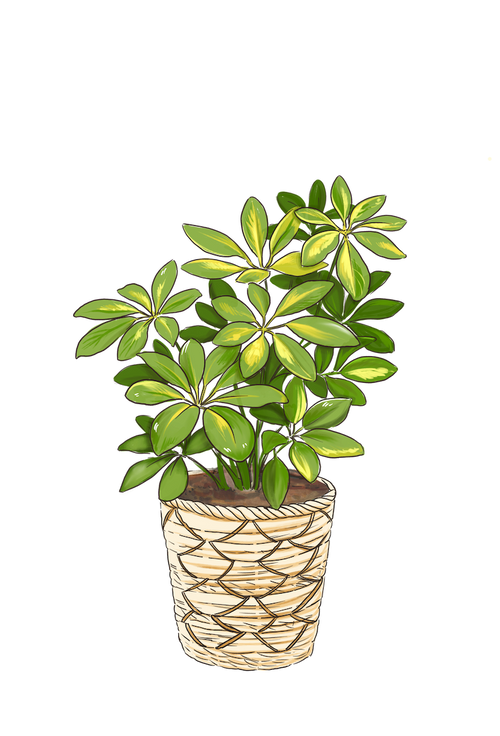Umbrella Tree Care Guide

-
Light : Medium
Prefers medium levels of indirect light.
-
Water : Low
Water well and then allow the soil to dry out between each watering.
-
Humidity : Medium
Enjoys humidity. Spritz occasionally.
-
Temp : 65℉ - 90℉
Keep this plant in rooms where the temperature is a comfortable 65°F-90°F and avoid cold drafts or air vents below 60°F.
-
Zone : 10|11
Outside: Keep in full shade on a patio out of direct sunlight to prevent leaf burn where nights are above 60°F.
-
Fertilizer : Seasonally
Fertilize throughout the spring, summer and fall every six weeks. Apply at half-strength a balanced, liquid fertilizer especially formulated for indoor plants and let rest in the winter.
-
Repotting : 3 Years
When receiving the Schefflera, do not repot immediately but wait at least 6-12 months or if the roots are beginning to get crowded and growing through the drainage holes.
Repot in the spring, using a 2 inches bigger pot to keep the roots drier. (Too big of a planter could cause the soil to dry slower.)
Place a piece of screening at the bottom of the container over the drainage hole to secure the soil and allow to drain. Use a well-draining indoor potting mix with perlite to help with drainage.
Water your plant in the old pot before transferring over and let sit an hour.
Add soil to the bottom to elevate the root ball. Lift the plant and release the roots against the existing planter. Use a clean knife or garden trowel to wedge between the pot and the soil to loosen.
Inspect the root ball. Notice if there are any dead or rotting roots and trim off with sterile pruners. If the plant is rootbound, loosen the roots to alleviate continued encircling.
Ensure the plant is sitting about 1 inch below the edge of the pot to avoid water spillage. Add more soil and backfill around the sides by tamping down. Fill up to the soil line but not over.
Water thoroughly, leaving the soil damp but not soggy. If settling occurs, add more soil.
Water well to dampen the soil and let drain.
-
Cleaning : Monthly
To clean the leaves and alleviate dust particles, give them a shower from above. Fill a watering can with filtered, distilled or tap water that has been sitting for 24 hours. Place the plant in a sink and lightly wash the leaves with a shower spray end watering can.
Trim off any brown leaf tips that may appear with sterile scissors. Remove any debris from the soil and replenish soil if needed. Inspect for any insects at this time.
-
Propagation : Cuttings
Take a stem cutting with sanitized pruners, 6-8 inches long with leaves attached.
Dip the cuttings in water, then in a rooting hormone.
Use a pot with drainage and place the stem 1-2 inches down into the damp, well-draining, moist potting soil mix and tamp down around the stem to secure.
Place a clear plastic bag over the cutting to mimic a greenhouse and mist the bag. Set in bright, indirect sunlight while they are rooting.
Check the moisture and humidity each day and add misting to keep the soil moist while the roots establish.
After 6-8 weeks, roots will begin to establish. You can tug onto the stem to ensure the roots are secure.
Remove the plastic bag but maintain adequate humidity around the new plant.
Prune from the top of the plant to encourage more branching.